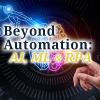Business Transformation Requires Transformational Leaders
Leadership and teaming skills are front and center in times of rapid change. Meet today’s constant disruption head on with expert guidance in leadership, business strategy, transformation, and innovation. Whether the disruption du jour is a digitally-driven upending of traditional business models, the pandemic-driven end to business as usual, or the change-driven challenge of staffing that meets your transformation plans — you’ll be prepared with cutting edge techniques and expert knowledge that enable strategic leadership.
Subscribe to Arthur D. Little's Culture & Leadership Newsletter
Insight
We present in this issue of CBTJ a set of five articles that provide actionable insights on topics of current interest to professionals and executives. We hope the articles inspire and encourage you to harness advanced automation in your domain of interest.
Although many organizations’ IT departments have begun to focus on quickly adopting emerging technologies, many of those organizations struggle to balance the need to deploy new technology with speed and agility while maintaining compliance with their organization’s traditional risk management frameworks. This struggle is why organizations adopting BaaS must shift from letter of the law (“box-checking compliance”) to spirit of the law (principles-based compliance) risk management (i.e., to risk-based methodologies whose foundational risk mitigation principles align with desired business outcomes).
In this Executive Update, we put a spotlight on the energy industry and offer a view of the challenges energy retailers face. We also examine various strategic moves companies should consider to reinvent themselves and stay relevant.
This on-demand webinar offers digital strategies and technologies that support oil & gas industry transformations, identifies possible scenarios for the industry in the post-COVID-19 world, and offer insight into two key areas companies need to focus on for the best chance to weather the COVID-19 storm.
Advisor
Communication with a Purpose
Increased communication among team members leads to a culture of transparency. Transparency is about making shared assumptions explicit. The more transparent teams and stakeholders are with one another, the more the organization understands priorities, and the sooner critical feedback loops get closed.
In this Advisor, I adapt the term “directional selection” to a business use to indicate the natural shift an organization goes through when one way of achieving a business goal has a better economic outcome, or directional selection, than any other alternative. Indeed, directional selection in complex, large organizations is the force behind the many changes required to increase an organization’s fitness.
In this edition of The Cutter Edge, you'll discover practical exercises that will help your organization achieve enterprise agility, how to create a solid business architectures that underpin successful business ecosystems, and how to prepare for the post-Corona era in the oil & gas industry.
Showing the Agile Manifesto to teams, managers, and stakeholders and discussing it in a two-hour Agile introduction session serves no practical purpose. We need instead to center mindset-based actions on the human aspect in order to achieve sustainability and generate better, high-quality value with a positive economic outcome for customers and the business. That healthy balance comes naturally from directional selection, which merges mindset, the human aspect, collaboration frameworks, and methods together.




















